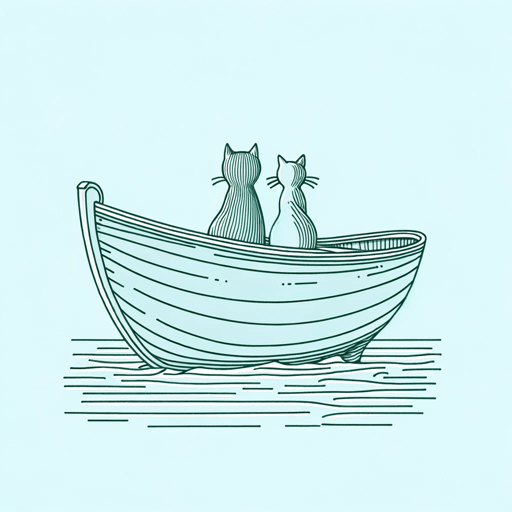21 pages • 42 minutes read
Edward LearThe Owl and the Pussy-Cat
Fiction | Poem | Adult | Published in 1871A modern alternative to SparkNotes and CliffsNotes, SuperSummary offers high-quality Study Guides with detailed chapter summaries and analysis of major themes, characters, and more.
Summary and Study Guide
Overview
“The Owl and the Pussy-Cat” by Edward Lear is one of the best-known children’s poems in English. A classic example of Victorian “nonsense” verse, the rhyming ballad was originally published in Nonsense Songs, Stories, Botany and Alphabets (1871). The poem comprises three 11-line stanzas, each ending in a refrain. Filled with whimsy and music, the poem features an owl and a cat who sail away to find a ring so they can get married. Their quest builds the poem’s main themes of perfect love, companionship, and wonder. The most popular of Edward Lear’s many limericks and poems, “The Owl and the Pussy-Cat” continues to delight audiences and was voted one of the UK’s top three most enduring children’s poems in 2014. In 1968, the poem was adapted as a song for soprano and piano by Russian classical music composer, Igor Stravinsky.
Poet Biography
Edward Lear (1812-1888), now widely regarded as a master of humorous and absurdist English verse, began his working life as an illustrator. Born in London, Lear was forced to find work at 15, as his stockbroker father was on the verge of bankruptcy. The 20th of his parents’ 21 children, Lear was ignored by his exhausted mother during his childhood, and raised by his oldest sister Ann. Ann would never get married and devoted her life to caring for Lear, who suffered from epileptic seizures since he was a child. Ann died in 1861.
Lear’s success as an illustrator of natural history specimens, especially birds, led to the publication Illustrations of the Family of Psittacidae in 1832, a volume of 12 folio lithographic prints of parrots. Lear’s depictions of animals and medical specimens led him to interact with many prominent naturalists and other patrons in London, including Edward Stanley, the Earl of Derby. Derby introduced Lear to wealthy art patrons, who commissioned several works from him. After Lear’s worsening eyesight made detailed illustrations of animals impossible, in 1837 he turned to landscapes. The love for landscape painting took Lear to Italy, Greece, and other parts of Europe for inspiration. He would remain bitten by the travel bug for the rest of his life, journeying to Jerusalem, India, and Sri Lanka, and eventually earning titles such as “the wanderer poet.”
It is unclear when Lear began writing what he termed his “nonsenses,” but he frequently composed verses for the children of his friends and patrons. In 1846, he published A Book of Nonsense, his first volume of limericks, to much acclaim. While Lear did not invent the limerick—a five-line humorous poem possibly of Irish origin—he did popularize it. Nonsense Songs, Stories, Botany and Alphabets, from which “The Owl and the Pussy-Cat” is taken, was published in 1871. Lear wrote the poem for Janet Symonds, the three-year-old daughter of his friends John Addington Symonds and Catherine Symonds. Lear published More Nonsense Pictures, Rhymes, Botany, etc. in 1872, and illustrated his close friend and poet Alfred Tennyson’s poems for an 1889 volume.
While illustrations brought Lear financial security and acclaim as a painter, his verse established him as a poet. Lear also composed music. Additionally, Lear had many friends and patrons among London’s art and literature circles. Still, the poet did not describe himself as particularly happy. He faced health issues and periods of depression throughout his life and did not seem to find romantic companionship. Biographers agree that Lear was attracted to men, a fact he would have to hide in conservative Victorian England. In 1870, Lear moved to San Remo, settling in a home he named Tennyson Villa. He passed away of heart disease in 1888.
Poem Text
Lear, Edward. “The Owl and the Pussy-Cat.” 1871. Poetry Foundation.
Summary
The omniscient third-person speaker of the poem relates the marriage tale of a lovestruck couple, the owl and the pussy-cat. One night, the owl and the pussy-cat take a “pea-green” (Line 2) boat for a romantic ride across the sea. For exigency, they have carried a large jar of honey as ration and a bundle of cash wrapped up in a five-pound note. The owl gazes at the starlit sky and pulls out a small guitar. Serenading the cat, the owl sings of her extraordinary beauty. The cat is moved by the owl’s song and praises his singing, elegance, and charm. The cat suggests they get married to each other as soon as possible, as they have already wasted too much time dithering. There is a problem, though: They don’t have a wedding ring to exchange.
In search of a ring (it is implied), the owl and the pussy-cat sail away to the land where the bong-tree grows. Their journey takes a year and a day. In the land of the bong-tree, they come upon a piggy-wig, or a pig, standing in a forest. As if waiting for them, the piggy wig is carrying a ring on the edge of its nose. Delighted, the owl and the pussy-cat offer the pig one shilling—12 pence—for the ring. The pig accepts. The owl and the pussy-cat take the ring and are married the next day by the turkey who lives on a hill in the land of the bong-tree. A wonderful feast follows the wedding. The newlyweds eat mince and the pear-like quince fruit using a precious runcible spoon. As night falls, the owl and the pussy-cat take each other’s hand and dance on the beach under the moon’s silvery light.

